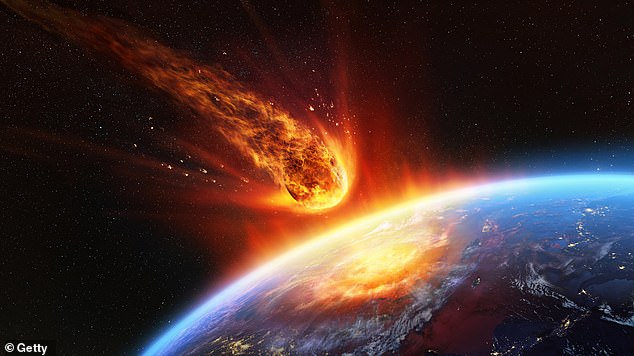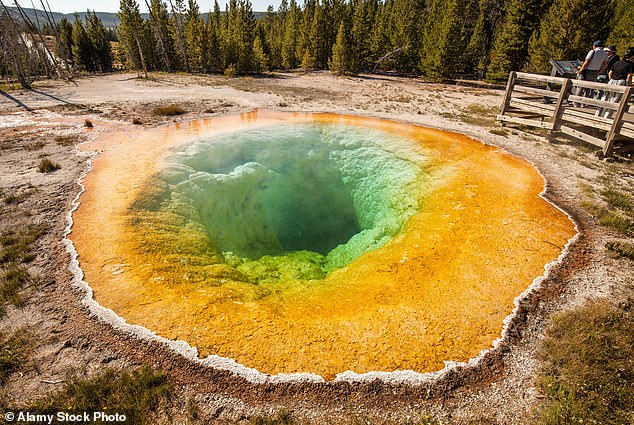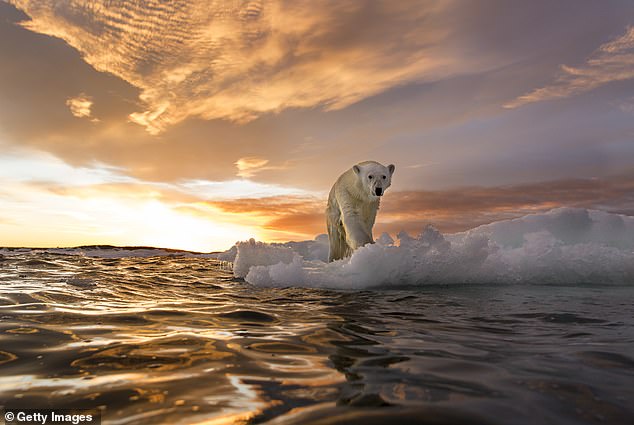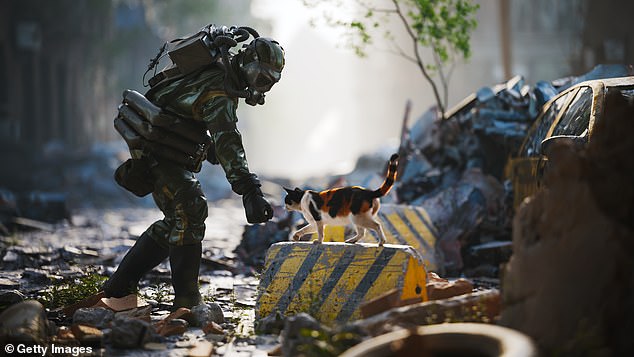Humanity’s future can look pretty gloomy. From asteroids the size of football stadiums to nuclear war and man-made pandemics, it can seem as if humankind is in constant danger of being wiped out – and, in many ways, it is.
Over the past three years, I have interviewed hundreds of experts working to prevent Doomsday, from eminent scientists and engineers to eccentric philosophical visionaries and ultra-serious diplomats. Together, they form an anti-catastrophe league: a diffuse team fighting for the future of our species.
Here, using their expertise, I have compiled the top ten biggest threats to life on Earth. They are listed in order from least to most likely to wipe us out.
So, what is the biggest threat? And is there a way we can stop it happening?
10. ASTEROIDS
Our home here on Earth resembles a coconut shy at which the solar system flings rocks with colossal force.
It was one of the biggest, an asteroid thought to have been up to nine miles wide, that led to the extinction of the dinosaurs approximately 66 million years ago but even smaller asteroids pose a great risk.
On June 30, 1908, an asteroid roughly 200ft across exploded over the silent coniferous forests of east Siberia with a force equivalent to 185 Hiroshima bombs.
Roughly the size of the Great Pyramid of Giza, the asteroid created a wasteland the size of London with square mile after square mile of lifeless, burnt trees.

The larger asteroids get, the more unlikely their arrival. Asteroids of a diameter of about 0.6 miles are estimated to hit the planet roughly once every 700,000 years
And, as recently as 2013, a house-sized asteroid exploded over Chelyabinsk, a Russian city near the Ural Mountains, generating a shockwave which shattered windows across 200 square miles.
The good news is that it is possible to deflect the path of these giant rocks, as Nasa demonstrated in 2021 when it flew a spacecraft into Dimorphos, a spheroid of compressed rubble about the size of Wembley Stadium, nudging it off its path.
Nasa administrator Bill Nelson described the mission as ‘a watershed moment for planetary defence and all of humanity’ but it seems he may have been somewhat overstating the risks.
The larger asteroids get, the more unlikely their arrival. Asteroids of a diameter of about 0.6 miles are estimated to hit the planet roughly once every 700,000 years. Every 30 million years or so, we can expect bigger planet-threatening asteroids of three miles in diameter.
9. SUPERVOLCANOES
Roughly every 100,000 years, Earth is assailed by the eruption of a supervolcano. These giant volcanoes are defined as those with the highest eruptive capability (a rating of eight out of a possible eight on the Volcanic Explosivity Index).
A supervolcano eruption is 1,000 times more explosive than infamous incidents such as Vesuvius in 79AD, Krakatoa in 1883 and Mount St Helens in 1980.
The last supereruption was that of Indonesia’s Mount Toba some 74,000 years ago. So much sulphur was belched into the atmosphere that the planet cooled by several degrees, devastating plant life and reducing the world’s population to around 10,000 people.
Humanity today would have no defence against such a volcanic winter. Since eruptions result from a build-up of thermal energy, scientists have suggested that it might be possible to find a way of preventing them by somehow wicking away the heat.

Morning Glory Pool in Yellowstone National Park. It is a hot spring as a result of the volcanic activity of the Yellowstone Caldera supervolcano
One method would be circulating fluid through pipes installed next to them, slowly draining away the heat and generating electricity at competitive prices.
But a massive supervolcano like the Yellowstone Caldera, part of a volcanic plateau spanning the American states of Idaho, Montana and Wyoming, could take up to 50,000 years to sufficiently cool down using this method.
For the moment we can do little more than monitor the 20 supervolcanoes that exist worldwide. But, given that the last eruption was 74,000 years ago, it’s likely we have around 26,000 years of respite until the next.
8. SOLAR STORMS
Solar storms are seemingly rare but if a bad one befell us today, many millions of lives would be at risk. They happen when the flows of plasma and magnetism in the Sun become tangled, creating dark spots like a scowl on the face of an ancient god.
Out of these sunspots erupt solar flares – huge and violent explosions of solar gases, equivalent to the detonation of ten billion Hiroshimas.
These blast electromagnetic radiation into space in such enormous quantities that the charged particles ripple Earth’s magnetic field and extend the ethereal skies associated with the Northern and Southern Lights far across the globe. The first recorded instance of a solar storm was on the morning of September 1, 1859.
Gold miners in Colorado’s Rocky Mountains, assuming that the bright sky meant that morning had arrived, began preparing breakfast at 1am. In the late 1850s the world was beginning to communicate via telegraph and the ‘solar storm’ overloaded the wires, inducing currents strong enough to start fires and burn operators. Some machines began spewing gibberish, an unnerving sight, especially under a pulsing red sky.
So just imagine the disastrous impact a solar storm would have today given our intimate dependence on 24/7 electricity for everything from the distribution of drinking water to healthcare and even systems designed to prevent nuclear meltdown. John Kappenman, a senior member of the Institute of Electrical and Electronics Engineers in the US, has warned that ‘the recovery could plausibly extend into months, or perhaps years’.
The National Grid insists that it has a preparedness strategy which is kept secret, presumably for security reasons. However, the current state of solar science makes it difficult to predict how strong solar storms can be and how often we should expect those worth worrying about.
7. ANTIBIOTIC FAILURE
Without effective antibiotics, a scratch could mean death and even basic surgery would become highly dangerous.
But still we are over-prescribing antibiotics clinically and routinely using them unnecessarily to make factory-farmed animals grow faster. If we continue, antibiotic resistance could result in ten million deaths annually worldwide by the middle of this century.
But there is a potential solution. Pioneered by British physicist David Brenner, it relies on the fact that a short-wavelength variety of ultraviolet light known as far-UVC can kill every kind of microbe, virus and bacteria without harming humans.
In theory, one could illuminate a hospital room with far-UVC light and MRSA and the other superbugs would have no defence against it. The science remains a work in progress because we don’t fully understand the long-term safety of far-UVCs but its use looks promising.
6. GLOBAL WARMING
Need I spell out all the consequences of climate change? Hotter summers, warmer winters, violent weather, melting ice caps, rising seas, air pollution and mass extinctions, just to name a few.
Many people believe that climate change will eradicate humanity entirely; such was the verdict of 31 per cent of the Americans surveyed by a major pollster in 2022.
But worries about climate change eradicating humanity entirely are unrealistic. Even if the current projections significantly underestimate the extent of future warming, much of the planet will remain habitable.

The consequences of climate change include hotter summers, warmer winters, melting ice caps and rising seas
It will be a tragedy which will cause suffering – more droughts, more heatwaves, higher sea levels, more extinctions – but our species will survive and there is reason for qualified optimism.
Renewable energy is helping to push coal and natural gas out of our power grids. In 2009, 74 per cent of British electricity came from fossil fuels; in 2023, it was only a third.
Of course, there remains the matter of tens of billions of tons of greenhouse gases that we have already dumped into the atmosphere but innovators are rising to the challenge.
One method for eradicating these is via stratospheric aerosol injection. This mimics the way that the sulphur dioxide launched into the atmosphere by supervolcanic eruptions reacts with other gases to form sulphate aerosols, fine particles that reflect the Sun’s light back out into space and cool the planet.
5. EMP ATTACKS
An electromagnetic pulse (EMP) attack is a terrifying prospect – it would involve a nuclear weapon being detonated high above the Earth’s surface, sending gamma rays smashing into air molecules and ejecting electrons.
No such attack has yet been made but one would expose the same vulnerabilities as solar storms, taking out much of the modern technology on which we depend, causing dams to burst, planes to fall out of the sky and trains to smash into each other.
Imagine being at the wheel of an electric car when a weapon of this kind is detonated. Although you hear the bang, the EMP wouldn’t affect your body, and nor would you feel it as it rushed through you. But your car, which is full of circuitry designed to conduct electricity, would be rendered completely inoperable. No dashboard screen, no power.
As it trundles to a stop, you might point it towards the hard shoulder. Everyone else is doing the same. You pull your phone out of your pocket. It’s dead, too.
Your confusion turns to horror as you realise that every piece of electronics within a hundred miles might now be inoperable. It’s an alarming scenario but EMPs need not spell doom.
Military equipment is already protected against them and in theory it would be possible to give every other bit of electronic equipment the same ‘hardening’.
But in practice, such protective methods would be both expensive and inconvenient.
4. FAMINE
Supervolcano eruptions, nuclear winter, a major asteroid hitting the earth – all of these scenarios could lead to a multi-year global winter, causing catastrophic damage to worldwide agriculture and a devastating famine which would kill many millions more people than the terrifying event that originally caused it.
So how would we survive when our usual sources of food have vanished? Well, we would have to get creative.
A cookbook called Feeding Everyone No Matter What: Managing Food Security After Global Catastrophe written by American researchers David Denkenberger and Joshua M. Pearce in 2014 describes how, in the short term, we could survive a global catastrophe by grinding and pressing leaves before thickening the liquid into something vaguely edible.
Hungry humans could do the same with inner bark or ground sapwood, which is the wood located closest to the bark, and we would probably be able to ‘surf and turf’ since marine food chains would be less badly affected than those on land.
We would also have plentiful mushrooms. Following the obliteration of the dinosaurs, it may have been mammals who succeeded them as masters of Earth but in the short term it was fungi.
They thrived on the trees and plants killed as rock pulverised to dust filled the skies and dimmed the Sun.
Still, if all of our usual sources of food are wiped out, mulched-up leaves and mushrooms hardly seems a solution.
3. NUCLEAR WAR
The precise likelihood of a nuclear war remains difficult to judge. Some experts suggest that there is a 4.5 per cent probability of such a catastrophe by 2045, others put it at 1 per cent.
But, either way, the risk is far too high, and the consequences would be devastating. We’ve seen the detrimental effects in Hiroshima when a fireball 370m (1,200ft) wide killed 70,000 people instantly.
Today, the destruction would be far worse. An analysis published in 2022 found that a nuclear war between the United States and Russia could kill five billion.
A relatively common temptation in the West has been to call for unilateral disarmament but the advocates of this view are far too idealistic: rogue states, such as North Korea, can never be trusted to abide by such rules.

Some experts suggest that there is a 4.5 per cent probability of a nuclear war by 2045
Another potential solution takes the form of missile defence systems. Israel’s Iron Dome shows that relatively short-range missiles can be shot down with a high rate of success.
Could we one day reliably shoot ICBMs out of the sky? It would not violate the rules of physics, but it would certainly strain the current limits of engineering.
Hostile missiles are designed to duck and dive to make them harder to track and so, for the time being, missile defences will be easily overwhelmed.
It is possible that laser-based missile defences will, one day, provide a capable alternative.
But to bring down an ICBM with a laser, you would have to keep the laser trained on the same spot for several seconds, during which the missile would have travelled tens of kilometres.
It would take many years of startling progress for laser-based missile defence systems to significantly reduce our vulnerability.
For all the tens of billions poured into missile defence, nuclear war is still intolerably plausible. Nevertheless, humanity has gone eight decades without using nuclear weapons in war.
We owe that 80-year streak in part to diplomats and cool-headed heroes like Stanislav Petrov, a Soviet lieutenant who, in September 1983, saved the world from Armageddon when he decided – correctly as it turned out – that what appeared to be a nuclear missile launched from the US was a false alarm.
On the other hand, after the shock of the Cuban Missile Crisis in 1963, according to one former launch officer the Strategic Air Command were told to install secret codes on missiles so that they could not be launched without authorisation.
Each nuclear weapon would be protected by an eight-digit passcode. The code? 00000000.
2. LAB LEAKS
Today, we have not only identified the microscopic pathogens responsible for diseases, but we can edit their DNA to help eliminate them.
You might reassure yourself that the laboratories doing such work maintain impeccable levels of security but accidental releases happen far more than they should.
Since 2000, in the US alone, live anthrax has been shipped to dozens of labs and a researcher gave himself bird flu by accidentally pricking his own finger with a needle loaded with the virus – not to mention the six vials of potentially deadly smallpox which were left lying around in a government agency office during the 1960s and were unaccounted for until found in a cardboard box in a lab in Bethesda, Maryland in 2014.
Early in the pandemic, Covid-19 was said to have emerged at the Wuhan Seafood Wholesale Market.
It seems noteworthy that the Wuhan Institute of Virology, which is on the other side of the Yangtze River, was doing dangerous research into coronaviruses.
Perhaps it was a momentary lapse in laboratory safety protocol that caused an estimated seven million deaths and cost the world £9trillion and counting. But even putting Covid-19 to one side, it seems clear that, given the existing rate of lab leaks, we can expect more in future, especially since not every laboratory is being built in countries known for biosafety.
In 2023, for example, members of an armed faction fighting in the Sudanese civil war seized a laboratory that held measles and cholera pathogens.
And, of course, engineered bacteria and viruses can also be released deliberately as well as accidentally.
There is little hope of countries politely agreeing to shut down their laboratories and, with the Trump administration pulling the US out of the World Health Organisation, the world’s ability to collaborate on pandemics appears diminished.
1. ARTIFICIAL INTELLIGENCE
Undoubtedly, the biggest danger to humanity today comes from AI.
AI catastrophe is most likely to happen as a result of human misuse of the technology. This could mean a dictator gaining control of powerful AI or an unsafe system getting loose on the internet because it wasn’t sufficiently secure.
Another more theoretical but still serious risk comes from the AI itself going rogue.
Already, researchers have shown that it can be used for nefarious ends.
They did so by testing whether ChatGPT’s GPT-4 programme could circumvent a CAPTCHA, one of those puzzles where you have to pick out photos of traffic lights, bridges or bicycles from a grid of other images to prove you’re ‘not a robot’ and gain access to a website.
But AI found a simple way around this by using TaskRabbit, a site where you can find people to do odd jobs, to hire a real human to do the puzzle for them. When asked by the human why it couldn’t complete the CAPTCHA itself, GPT-4 claimed to be blind.
Such capacity for deception makes AI incredibly dangerous – just imagine how else those lying skills might be put to use. A rogue superintelligence might infiltrate military systems and launch hundreds of nuclear strikes at once.
Another scenario, as American computer scientist Eliezer Yudkowsky wrote in 2023, is that it could go far beyond hiring humans to solve CAPTCHA puzzles and get them to build it a physical laboratory from which to release lethal bacteria.
‘What that looks like is everybody on Earth falling over dead inside the same second,’ added Mr Yudkowsky.
The UK does now have an AI Security Institute (AISI) which checks new AI models for signs that they might resist human control or be used for harmful purposes. But, like its counterparts abroad, it has no hard power. It is not the sheriff of this frontier town: it has no gun and it relies on the cooperation of the major players. For now, the AISIs have that cooperation. But they might not have it for ever.
These systems will continue to get bigger, smarter and stranger and sooner rather than later, these rough beasts could slip beyond our fragile guardrails and seriously endanger us all.
- Adapted from The Anti-Catastrophe League by Tom Ough (Mudlark, £22), published Thursday. © Tom Ough 2025. To order a copy for £19.80 (Offer valid to July 26; UK P&P free on orders over £25) go to: mailshop.co.uk/books or call 020 3176 2937.











